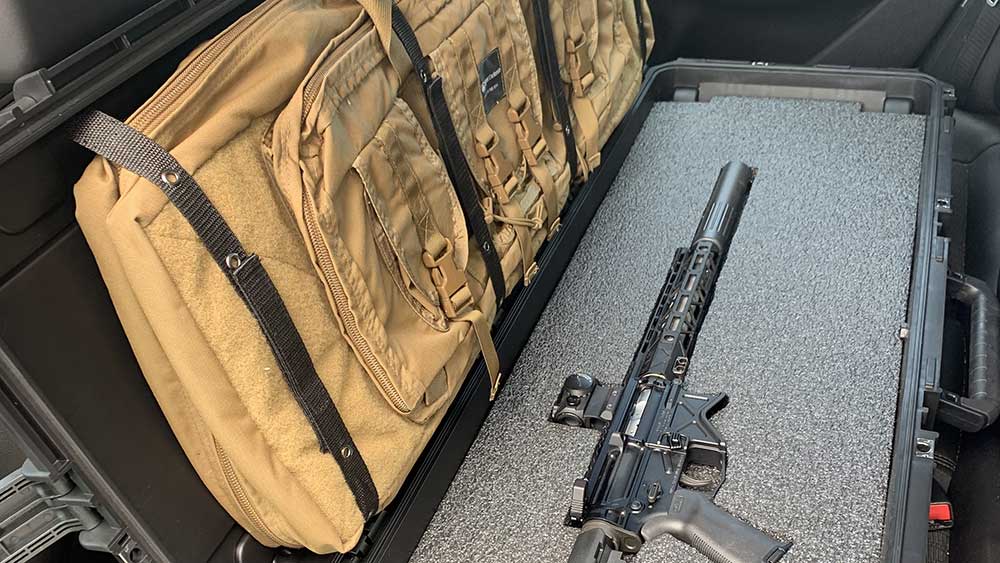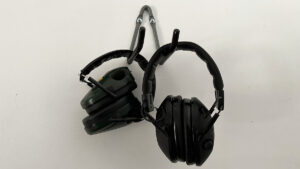We independently choose and evaluate products.
If you purchase using our links, we may receive a commission, which helps fund our product testing.
Should I get a Hard Rifle Case or Soft Case Rifle Case for my AR-15?

Trending: Best Body Armor, Best AR-15s, Best Pistol Red Dots, Best LPVO
Decisions. Decisions. Finally! You have decided to replace that old Walmart AR-15 case you bought a few years ago, and you’re faced with another decision—whether to go with a soft or hard case.
On the surface, it doesn’t appear to be such a difficult decision. But, like most decisions, the more you think about it, the more confused you get. It’s not black and white; there are plenty of gray areas to consider. And it’s not necessarily a choice that’s either right or wrong.
First of all, ask yourself if you really need a rifle case. That’s the easiest part of the decision-making process since unless you intend to leave your rifle in the gun cabinet to gather dust, the answer is a resounding “Yes.”
After all, you probably wouldn’t own a rifle if you didn’t enjoy long-range target shooting. Many even the occasional 3-Gun Shooting Competition, both of which require you, your rifle, and guns to travel.
So, now that everyone agrees that it is necessary let’s look at a brief history of the rifle case and find out what has changed over the years.
It all started in the Old West
The first full-length rifle cases appeared in the 1830s and were primarily used to protect the rifle.
Made by the American Indians from a single piece of deer or elk hide that covered the entire rifle, they were sewn across the main seam and decorated with fringes. The early frontiersmen, appreciating the value of their rifles, traded for these protective cases.
While these early cases did a good job of protecting the rifles, they did nothing to help the Plainsmen transport them on horseback. They were forced to balance them on the saddle pommel until someone came up with a leather sleeve, known as a horn loop, which was attached to the saddle horn and allowed the rifle to be placed into it with the muzzle down.
With the saddle horn, the rifle could now travel, but it had lost much of its protection. And it wasn’t until after the Civil War, around 1870, that the saddle scabbard made transportation and protection possible.
The full-length sheath of leather was attached to the pommel and the back of the saddle, allowing the rifle to be carried with the butt forward. Anyone who has seen reruns of Gunsmoke, Wagon Train, or any other TV westerns from the 50s and 60s has also seen some version of the saddle scabbard.

Today’s Soft Rifle Cases
Someone once said that the more things change, the more they stay the same. So it is with rifle cases. While you might not be hunting buffalo across the western prairies, you still require the same elements in your rifle case—protection and transportability.
The men and women who own rifles are passionate about shooting sports and their equipment. They want to be able to attend their favorite events and provide safe passage for their treasured rifles.
Here are a few points to consider:
Soft rifle cases offer some distinct advantages
Soft rifle cases get their biggest advantage from being lightweight and easy to carry, something every shooting competitor can appreciate. Water-resistance is another advantage of a soft case, for those rainy days on the range.
In the past, one of the raps on soft cases was their inability to secure a rifle as well as a hard case does. Let’s face it; you don’t want your rifle moving around inside your case. But there are now double soft cases, like ours, with three interior straps that you can configure to ensure that your rifle remains fixed and secure.
There are also tactical gun cases that allow you to secure your rifle’s buttstock using barrel and rifle retention methods. Our rifle gun case is one of the few on the market that comes with a detachable divider that can double as a gun mat.
All in all, soft cases have come a long way. Besides providing more secure transportation for your rifle, they offer the flexibility of zippered pockets to carry ammo, magazines, cleaning equipment, and even storage for your small arms.
How many rifles will you carry?
You have to ask yourself the question, how many rifles will you be carrying? This is important because many hard cases don’t allow you to carry multiple rifles. Most soft cases are double soft rifle case configurations and allow you to carry two or possibly even three rifles.
So if your hard case isn’t one that allows you to configure it to carry multiple rifles I’d suggest looking for something like a soft tactical rifle case.
If you’re flying, you’ll need to choose a hard rifle case
Most of your shooting competitions will be within driving distance. There will come a time when a huge event will lure you to a distant state like Montana. And if you happen to live in North Carolina, you won’t want to be driving those 1800 miles.
The Transportation Security Administration (TSA) says, your rifle must be transported in a locked hard-sided container as checked baggage only.
The TSA-approved hard case must completely secure the unloaded firearm from being accessed. This means it must be locked, and only you will have the key or combination.
A lot of people use pelican cases for their hard cases but personally, I prefer Patriot Cases hard cases.
Aluminum or plastic materials typically make up the exterior of hard gun cases. Hard cases provide better protection from outside forces and contain an interior foam lining that prevents the rifle from moving around.
These are important factors if you’re flying, but, on the downside, hard cases are heavier and bulky enough to make transporting them difficult. And, they are more expensive.
If you must fly with your rifle, pay close attention to the TSA’s strict guidelines, and buy a hard case that meets their requirements.
But take along a lightweight, soft case for use at the competition itself. It makes no sense to burden yourself with that extra weight once you get off the plane at your destination.
Safety First, Always.
No matter which rifle case you choose, soft or hard, you should be able to lock it. Hard cases often come with a locking system, and soft cases usually have zippers that can be padlocked.
A locked case helps to keep children away from your rifles and makes it harder for thieves.
Don’t trust your rifle case purchase to just anyone
Many people carry scoped rifles and have a case to protect the gun and the scope. Transporting your bolt rifle or AR-15 style rifle can be cumbersome, but it doesn’t have to be.
Here at Lynx Defense, we are committed to manufacturing high-quality, long-lasting products, and they are 100% Made in America! That’s right! Quality American materials and labor go into every product made for everyone who loves shooting sports and range days!
Still not convinced? We put together a gun bag guide just for you!






Not a Bobcat Podcast
Monthly Podcast on Guns, Bags, and Industry
Concealed Carry Insurance
Protect yourself and all those who carry concealed in your house.